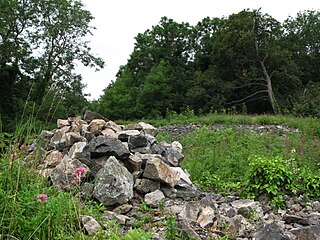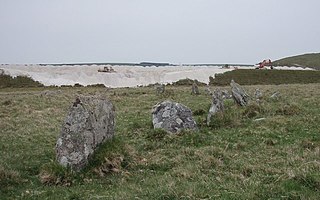Related Research Articles

Sabine Baring-Gould of Lew Trenchard in Devon, England, was an Anglican priest, hagiographer, antiquarian, novelist, folk song collector and eclectic scholar. His bibliography consists of more than 1,240 publications, though this list continues to grow. His family home, the manor house of Lew Trenchard, near Okehampton, Devon, has been preserved as he had it rebuilt and is now a hotel. He is remembered particularly as a writer of hymns, the best-known being "Onward, Christian Soldiers", "Sing Lullaby", and "Now the Day Is Over". He also translated the carol "Gabriel's Message" from the Basque language to English.

William Stukeley was an English antiquarian, physician and Anglican clergyman. A significant influence on the later development of archaeology, he pioneered the scholarly investigation of the prehistoric monuments of Stonehenge and Avebury in Wiltshire. He published over twenty books on archaeology and other subjects during his lifetime.

The Stanton Drew stone circles are just outside the village of Stanton Drew in the English county of Somerset. The largest stone circle is the Great Circle, 113 metres (371 ft) in diameter and the second largest stone circle in Britain ; it is considered to be one of the largest Neolithic monuments to have been built. The date of construction is not known, but is thought to be between 3000 and 2000 BCE, which places it in the Late Neolithic to Early Bronze Age. It was made a scheduled monument in 1982.
The Royal Society of Antiquaries of Ireland is a learned society based in Ireland, whose aims are "to preserve, examine and illustrate all ancient monuments and memorials of the arts, manners and customs of the past, as connected with the antiquities, language, literature and history of Ireland". Founded in 1849, it has a countrywide membership from all four provinces of Ireland. Anyone subscribing to the aims of the Society, subject to approval by Council, may be elected to membership. Current and past members have included historians, archaeologists and linguists, but the Society firmly believes in the importance of encouraging an informed general public, and many members are non-professionals.

Swinside, which is also known as Sunkenkirk and Swineshead, is a stone circle lying beside Swinside Fell, part of Black Combe in southern Cumbria, North West England. One of around 1,300 recorded stone circles in the British Isles and Brittany, it was constructed as a part of a megalithic tradition that lasted from 3,300 to 900 BC, during what archaeologists categorise as the Late Neolithic and Early Bronze Ages.

Colonel Henry George Herbert, 2nd Earl of Carnarvon DL, FSA, styled The Honourable Henry Herbert from 1780 to 1793 and Lord Porchester from 1793 to 1811, was a British peer, nobleman, and Whig politician.

Robert Bald FRSE FSA MWS (1776–1861) was a Scottish surveyor, civil and mining engineer, and antiquarian. Robert Bald was one of the earliest and most eminent mining engineers and land surveyors in Scotland, and by the late nineteenth century he was referred to as "the acknowledged father of mining engineering in Scotland".
Charles Fraser-Mackintosh was a Scottish lawyer, land developer, author, and independent Liberal and Crofters Party politician. He was a significant champion of the Scottish Gaelic language in Victorian Britain.

Worlebury Camp is the site of an Iron Age hillfort on Worlebury Hill, north of Weston-super-Mare in Somerset, England. The fort was well defended with numerous walls, embankments and ditches around the site. Several large triangular platforms have been uncovered around the sides of the fort, lower down on the hillside. Nearly one hundred storage pits of various sizes were cut into the bedrock, and many of these had human remains, coins, and other artefacts in them. During the 19th and 20th centuries the fort suffered damage and was threatened with complete destruction on multiple occasions. Now, the site is a designated Scheduled monument. it falls within the Weston Woods Local Nature Reserve which was declared to Natural England by North Somerset Council in 2005.

Craddock Moor Stone Circle or Craddock Moor Circle is a stone circle located near Minions on Bodmin Moor in Cornwall, UK. It is situated around half a mile Northwest of The Hurlers.

Stannon stone circle is a stone circle located near St. Breward on Bodmin Moor in Cornwall, England.

Duloe stone circle or Duloe circle is a stone circle near the village of Duloe, located 5 miles (8.0 km) from Looe in southeast Cornwall, England, UK.

Fernacre, also known as Fernacre stone circle or Fernacre circle, is a stone circle located on the slopes of the De Lank River, 1.25 miles (2.01 km) northeast of St Breward on Bodmin Moor in Cornwall in the United Kingdom.

The Trippet stones or Trippet stones circle is a stone circle located on Manor Common in Blisland, 9 kilometres (5.6 mi) north northeast of Bodmin on Bodmin Moor in Cornwall, UK. The Stripple stones are nearby.

The Stripple stones is a henge and stone circle located on the south slope of Hawk's Tor, Blisland, 10 kilometres (6.2 mi) north northeast of Bodmin on Bodmin Moor in Cornwall, England, UK.

Storage pits are underground cists that were used historically to protect the seeds for the following year's crops, and to stop surplus food from being eaten by insects and rodents. These underground pits were sometimes lined and covered, for example with slabs of stone and bark and tightly sealed with adobe.
The Clifton Antiquarian Club is an archaeological society founded in 1884 in Bristol to investigate antiquities in the surrounding areas of western England and southern Wales. The 28 years of research undertaken by the members and associates of the original society fill the first seven volumes of the Proceedings of the Clifton Antiquarian Club. The original club was dissolved in 1912, but it was resurrected in 2006. Four additional volumes of Proceedings have been published by the club in its current incarnation.

Charles Warne was an English antiquarian and archaeologist who specialized in the prehistoric and ancient monuments of Dorset.

William James Knowles was an Irish amateur archaeologist.
References
- 1 2 Foster, Joseph (1891). The Pedigree of Wilson of High Wray and Kendal. BiblioBazaar, LLC. p. 4. ISBN 978-1-141-22853-9.
- ↑ The Annual Monitor for 1916, Being an Obituary of Members of the Society of Friends in Great Britain and Ireland, p. 25-38 ().
- ↑ Dymond, Charles William (1886). Worlebury, an ancient Stronghold in the County of Somerset. John Wright and Co. Printer, Stone Bridge.
- ↑ Aubrey Burl: Great Stone Circles, fables, fiction facts. New Haven, Yale University Press 1999, p. 175. ISBN 0-300-07689-4
- ↑ A. L. Lewis, On three Stone Circles in Cumberland, with some further Observations on the Relation of Stone Circles to adjacent Hills and outlying Stones. Journal of the Anthropological Institute of Great Britain and Ireland 15, 1886, 475
- ↑ The Annual Monitor for 1916, Being an Obituary of Members of the Society of Friends in Great Britain and Ireland, p. 30
- ↑ Marchand, Jane (1993). "Sabine Baring-Gould, Archaeologist" (PDF). SBGAS Newsletter. Sabine Baring-Gould Appreciation Society. p. 14. Retrieved 15 October 2018.
In 1900 they were both elected Honorary Fellows of the Society of Antiquaries of Scotland. Others elected that year included Charles W. Dymond...